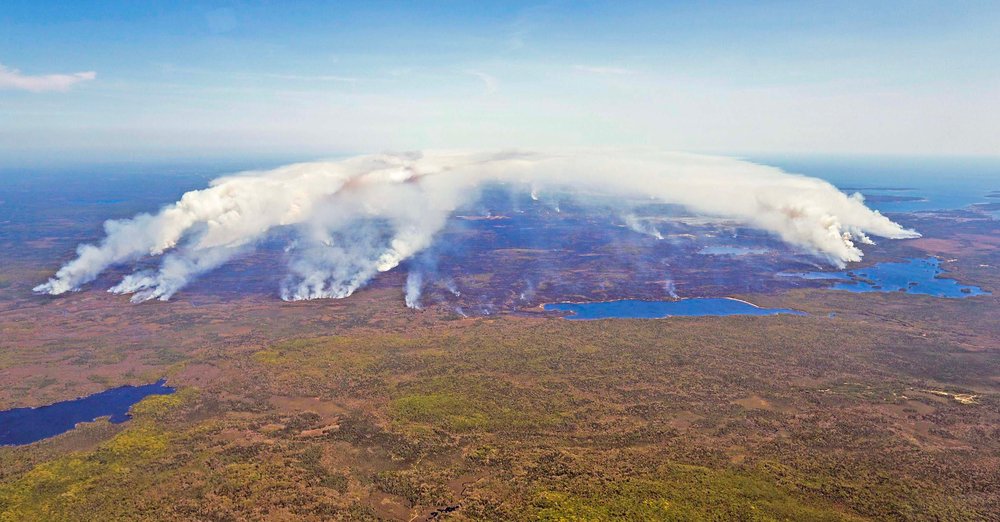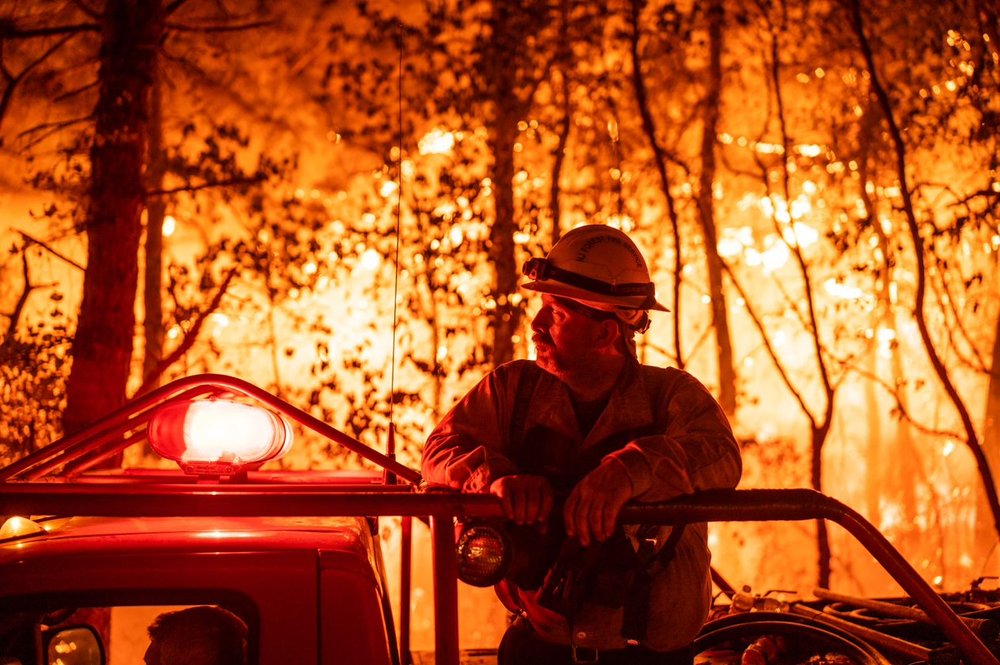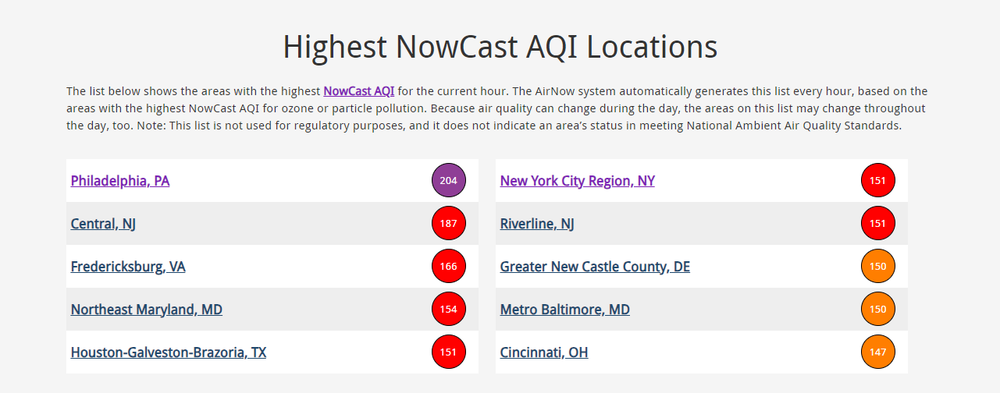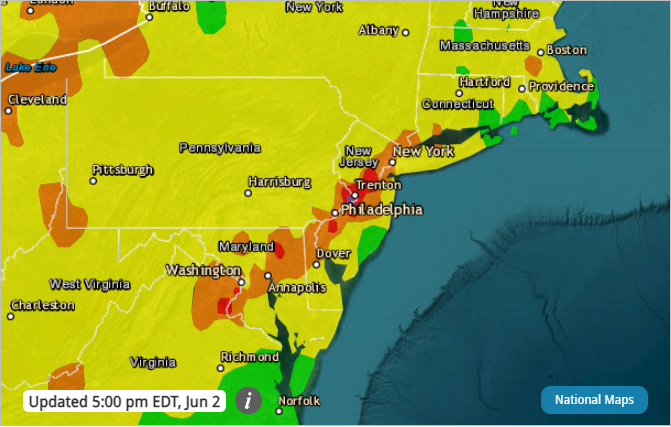The air is bad and 'very unhealthy.' But relief is coming for NY and NJ.
June 2, 2023, 8:44 p.m.
Friday afternoon capped a week of unhealthy air quality, which could be the norm this summer. Here’s how New Yorkers and Jerseyans can track what’s happening.

Catching a breath probably felt harder Friday afternoon than it has all year, as air quality levels stretching from New York City to Washington D.C. vaulted into danger zones. It capped a recent spell of unhealthy air – driven first by wildfires but then by ozone, a hazardous air pollutant that is produced in hot, humid weather.
“Smoke particles in the air — that does degrade the air quality. And that's how we had air quality issues earlier in the week,” said meteorologist Garett Argianas. “Now, the focus is on what we call ground-level ozone.”
On Tuesday, a massive wildfire in the eastern Canadian province of Nova Scotia tossed a trail of smoke down the eastern seaboard, increasing the amount of particulate matter floating near the ground.
⚠️A plume of Canadian wildfire smoke is forecast to drift over the area Tuesday and could lead to decreased air quality.
— NWS New York NY (@NWSNewYorkNY) May 29, 2023
Here's one model's depiction of the smoke, where orange colors correlate to concentrations of 25μg/m3 or greater. #NYwx #CTwx #NJwx pic.twitter.com/rj86sAqKF7
Particulate matter, namely pieces smaller than 2.5 microns, can be breathed deep into the lungs and goes by the term “PM2.5.” Short-term exposure irritates the eyes and respiratory tract, leading to shortness of breath — while prolonged experiences can worsen asthma and heart disease.
Particulate matter is already common in urban areas like New York City, due to the burning of fossil fuels. The Nova Scotia smoke just layered more particulate matter onto what’s already a persistent problem in the metro area. Real-time air monitors across the city recorded a huge spike in PM2.5 just after Memorial Day.

Those levels jumped again Friday, due to another blaze — the Allen Road Wildfire in New Jersey’s Bass River State Forest. By the afternoon, state officials reported the wildfire had grown to 5,000 acres, shutting down 25 miles of the Garden State Parkway between Atlantic County and Ocean County.
The hot, humid weather worsened air quality on Friday by producing ground-level ozone. As explained by the U.S. Environmental Protection Agency, higher temperatures on stagnant days can cause already hazardous emissions from cars and industrial facilities to chemically react, creating dangerous amounts of ozone near the surface of the Earth. (Ozone that’s made naturally in the upper atmosphere is beneficial, shielding lifeforms from UV rays.)

The wildfire smoke plus ozone combined to push hazard warnings in New York City, Trenton and Philadelphia toward the worst rankings on the air quality index (AQI). Philadelphia had the worst AQI in the country around 5 p.m. Friday — with a 204 rating that’s considered “very unhealthy.”
Central New Jersey was ranked second, while the NYC region was sixth. Real-time air monitors on the Queensboro Bridge recorded a PM2.5 spike Friday afternoon that surpassed the peak witnessed on Tuesday.
Argianas said it’s been a remarkable couple of weeks with Canadian smoke in the air, going back to wildfires that sparked in western provinces back in early May. But although those western blazes cast a haze over the city, he said they didn’t contribute to tri-state breathing problems, because the smoke was too high up in the atmosphere.

“The stuff from way out in Western Canada did not impact the air quality at the ground around here, but it was the fires that were closer to us,” Argianas said.
And he predicted that air quality will improve this weekend once rain and cooler weather arrive — to wash away the particulate matter and stymie the production of ozone.
“We'll have a cold front come by, and we'll see the wind shift,” Argianas said. “First of all, you're going to notice a huge change in the feel of the weather as the kind of summer preview goes away for at least a couple of days, and temperatures will be much cooler over the weekend.”
But the summer appears on track for more poor air, as New Jersey’s fire season is already outpacing last year.
- heading
- For people who want to track air quality...
- image
- image
- None
- caption
- body
- The U.S. Environmental Protection Agency offers a near real-time dashboard and searchable maps.
- The same goes for the New York City health department and the New Jersey Department of Environmental Protection.
- The New York State Department of Environmental Conservation also provides daily updates.